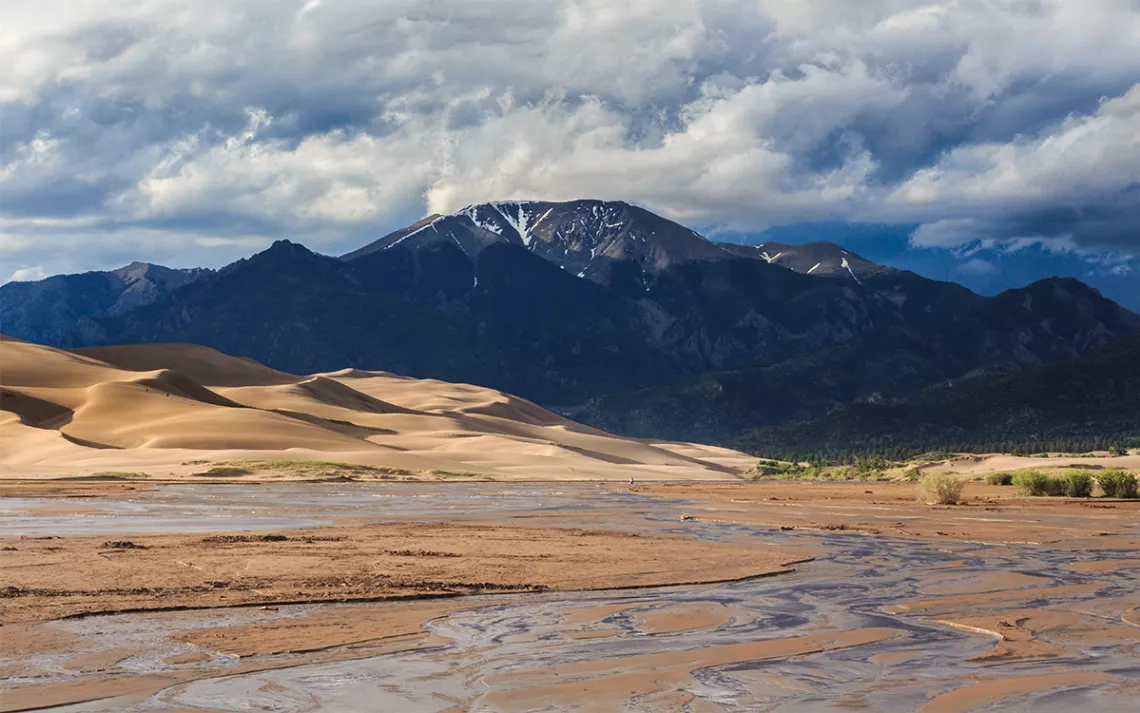Public Blasts Proposal for Oil and Gas Leasing Near Colorado National Park
The fate of lands neighboring Great Sand Dunes National Park is uncertain

Great Sand Dunes National Park | Photo by Gary Gray/iStock
Update: On July 10, 2018, the Bureau of Land Management announced that it will defer oil and gas lease sales in Huerfano County near Great Sand Dunes National Park pending consultation with Navajo Nation officials. The Navajo Nation, which owns 26 square miles of ancestral land near Great Sand Dunes, requested formal consultation with the BLM after the agency announced its plans for the lease sales this spring. The BLM agreed, but maintains that the land could still be offered at a future auction.
The Interior Department is proposing to open public lands near Great Sand Dunes National Park and the Sangre de Cristo Wilderness in Colorado to oil and gas leasing, but the public has given that idea a big thumbs-down.
Last week marked the end of a brief, 15-day comment period for people to weigh in on the Bureau of Land Management’s plans to lease 11 parcels near the popular wildland destinations. Of the nearly 4,000 comments received by the BLM, over 2,500 comments opposing the leases were sent from the Sierra Club Colorado’s Our Wild America campaign alone.
Jayson Barangan, a public affairs specialist for BLM Colorado’s state office, emphasizes that the proposed oil and gas leases are not located within the boundaries Great Sand Dunes National Park. “There was some misinformation when this story was first announced,” he says. The parcels are located in Huerfano County, east of the Sangre de Cristo Mountains, which hug the eastern boundary of the national park (the park’s eponymous dunes are on the western side).
Environmental groups say they understand perfectly well the location of the parcels (the Sierra Club even mapped them out) and say the proposed oil and gas drilling is still a bad idea. Conservationists caution that drilling would impact the park’s visitor experience because the parcels are all located within eight miles of the national park or wilderness.
“Great Sand Dunes National Park has over 300,000 visitors a year to experience the dark night skies, hike in the wilderness, and get some wonderful solitude that’s really hard to find anywhere else,” says Kimberly Pope, a Sierra Club Our Wild America organizer in Colorado. “We’re not even sure there are resources available on these parcels.”
“The eastern boundary of the Great Sand Dunes National Park skirts the summit of Sangre de Cristo. If the visitors choose to summit, they may see some oil and gas development if the parcels are leased,” Barangan admits.
There are also concerns about the impacts of oil and gas development on natural resources in the park and surrounding areas. According to Christine Canaly, director of the San Luis Valley Ecosystem Council, herds of wild elk, deer, and antelope frequent the area. The leases are also located in the Upper Huerfano Valley, where a thick web a tributaries could be impacted by pollution and water use by oil and gas development. Air quality is a concern as well; the park’s winds blow from east to west during the night, and any pollution from the oil and natural gas production would blow into the park along with it.
Moreover, there is some skepticism about the economic viability of the claims. “Putting up leases for auction is a far cry from actually drilling and being economically successful,” says Dale Lyons, Huerfano County liaison to the oil and gas industry. “None of the wells they have explored in this area have proven to be economically successful.”
The political response to the proposed leases has been mixed. Colorado governor John Hickenlooper, a two-term Democrat and former energy industry geologist, originally planned to send a letter opposing the leases. Eventually he decided against opposing the project once he learned the leases are near the eastern boundary of the park, instead of the western side near the iconic dunes.
"After numerous discussions with the DNR [Colorado Department of Natural Resources], the National Park Service, and the acting state director of BLM, we decided a letter was not needed at this time,” Jacque Montgomery, press secretary for Governor Hickenlooper, wrote in an email to Sierra. “DNR will monitor this evolving process closely to ensure concerns are being addressed."
The Colorado Senate’s Democratic caucus reached the opposite conclusion. Its members wrote a letter last Friday to the BLM’s acting Colorado director saying, “the federal push to auction off pristine public lands is a threat to communities in southern Colorado.”
“Drilling near the dunes would be a disaster for local economies that rely on tourism driven by southern Colorado's natural beauty,” said Senator Leroy Garcia in a email to Sierra. “We have a moral responsibility to preserve our public lands for future generations—that means extraction and pollution must be kept far, far away."
The leases follow a nationwide effort by the Department of the Interior to open up public lands for oil and gas development to fulfill the Trump administration’s energy dominance agenda. In March, Interior Secretary Zinke began selling off oil and gas leases in Utah near the former boundaries of Bears Ears National Monument. The difference in Colorado is that while the government owns the subsurface mineral rights needed for oil and gas development, the land’s surface is mostly privately owned thanks to the split estate laws throughout much of the Rocky Mountain West.
“Because it’s on private land, it quite frankly makes it incredibly difficult to stop,” says Canaly from the San Luis Valley Ecosystem Council. “Any time anyone does anything on private land, it’s like it’s sacrasant.”
The BLM will review the comments and expects to issue a decision on the drilling leases on July 20, which will be followed by a 10-day protest period. The agency expects to make a final decision in September.
 The Magazine of The Sierra Club
The Magazine of The Sierra Club



